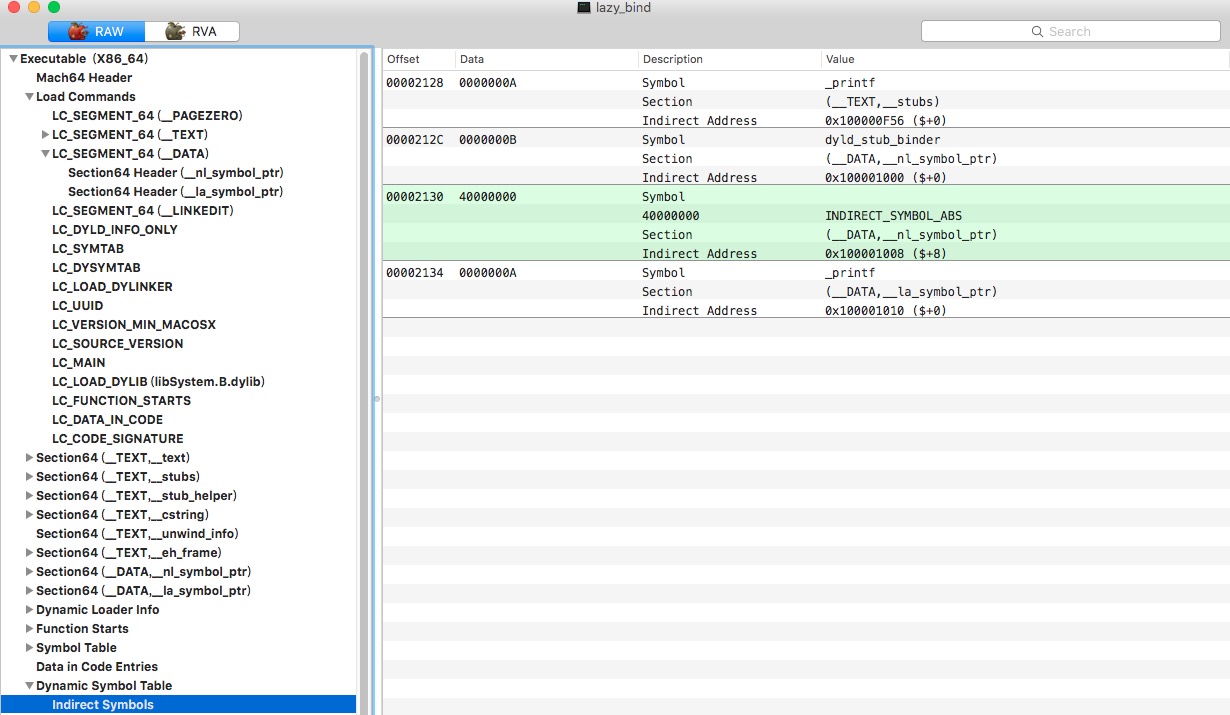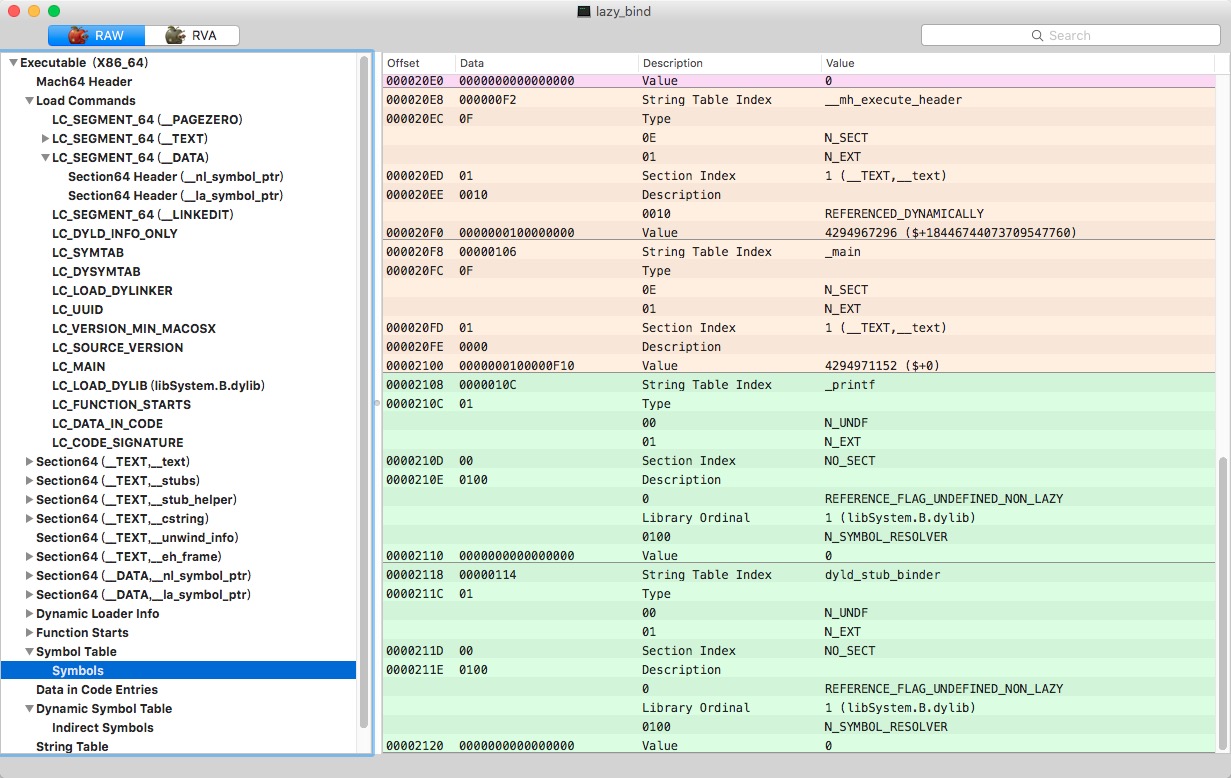1
2
3
4
5
6
7
8
9
10
11
12
13
14
15
16
17
18
19
20
21
22
23
24
25
26
27
28
29
30
31
32
33
34
35
36
37
38
39
40
41
42
43
44
45
46
47
48
49
50
51
52
53
54
55
56
57
58
59
60
61
62
63
64
65
66
67
68
69
70
71
72
73
74
75
76
77
78
79
80
81
82
83
84
85
86
87
88
89
90
91
92
93
94
95
96
97
98
99
100
101
102
103
104
105
106
107
108
109
110
111
112
113
114
115
116
117
118
119
120
121
122
123
124
125
126
127
128
129
130
131
132
133
134
135
136
137
138
139
140
141
142
143
144
145
146
147
148
149
150
151
152
153
154
155
156
157
158
159
160
161
162
163
164
165
166
167
168
169
170
171
172
173
174
175
176
177
178
179
180
181
182
183
184
185
186
187
188
189
190
191
192
193
194
195
196
197
198
199
200
201
202
203
204
205
206
207
208
209
210
211
212
213
214
215
216
217
218
219
220
221
222
223
224
225
226
227
228
229
230
231
232
233
234
235
236
237
238
239
240
241
242
243
244
245
246
247
248
249
250
251
252
253
254
255
256
257
258
259
260
261
262
263
|
#import "fishhook.h"
#import <dlfcn.h>
#import <stdlib.h>
#import <string.h>
#import <sys/types.h>
#import <mach-o/dyld.h>
#import <mach-o/loader.h>
#import <mach-o/nlist.h>
#ifdef __LP64__
typedef struct mach_header_64 mach_header_t;
typedef struct segment_command_64 segment_command_t;
typedef struct section_64 section_t;
typedef struct nlist_64 nlist_t;
#define LC_SEGMENT_ARCH_DEPENDENT LC_SEGMENT_64
#else
typedef struct mach_header mach_header_t;
typedef struct segment_command segment_command_t;
typedef struct section section_t;
typedef struct nlist nlist_t;
#define LC_SEGMENT_ARCH_DEPENDENT LC_SEGMENT
#endif
#ifndef SEG_DATA_CONST
#define SEG_DATA_CONST "__DATA_CONST"
#endif
struct rebindings_entry {
struct rebinding *rebindings;
size_t rebindings_nel;
struct rebindings_entry *next;
};
static struct rebindings_entry *_rebindings_head;
static int prepend_rebindings(struct rebindings_entry **rebindings_head,
struct rebinding rebindings[],
size_t nel) {
struct rebindings_entry *new_entry = malloc(sizeof(struct rebindings_entry));
if (!new_entry) {
return -1;
}
new_entry->rebindings = malloc(sizeof(struct rebinding) * nel);
if (!new_entry->rebindings) {
free(new_entry);
return -1;
}
memcpy(new_entry->rebindings, rebindings, sizeof(struct rebinding) * nel);
new_entry->rebindings_nel = nel;
new_entry->next = *rebindings_head;
*rebindings_head = new_entry;
return 0;
}
static void perform_rebinding_with_section(struct rebindings_entry *rebindings,
section_t *section,
intptr_t slide,
nlist_t *symtab,
char *strtab,
uint32_t *indirect_symtab) {
uint32_t *indirect_symbol_indices = indirect_symtab + section->reserved1;
void **indirect_symbol_bindings = (void **)((uintptr_t)slide + section->addr);
for (uint i = 0; i < section->size / sizeof(void *); i++) {
uint32_t symtab_index = indirect_symbol_indices[i];
if (symtab_index == INDIRECT_SYMBOL_ABS || symtab_index == INDIRECT_SYMBOL_LOCAL ||
symtab_index == (INDIRECT_SYMBOL_LOCAL | INDIRECT_SYMBOL_ABS)) {
continue;
}
uint32_t strtab_offset = symtab[symtab_index].n_un.n_strx;
char *symbol_name = strtab + strtab_offset;
struct rebindings_entry *cur = rebindings;
while (cur) {
for (uint j = 0; j < cur->rebindings_nel; j++) {
if (strlen(symbol_name) > 1 &&
strcmp(&symbol_name[1], cur->rebindings[j].name) == 0) {
if (cur->rebindings[j].replaced != NULL &&
indirect_symbol_bindings[i] != cur->rebindings[j].replacement) {
*(cur->rebindings[j].replaced) = indirect_symbol_bindings[i];
}
indirect_symbol_bindings[i] = cur->rebindings[j].replacement;
goto symbol_loop;
}
}
cur = cur->next;
}
symbol_loop:;
}
}
static void rebind_symbols_for_image(struct rebindings_entry *rebindings,
const struct mach_header *header,
intptr_t slide) {
Dl_info info;
if (dladdr(header, &info) == 0) {
return;
}
segment_command_t *cur_seg_cmd;
segment_command_t *linkedit_segment = NULL;
struct symtab_command* symtab_cmd = NULL;
struct dysymtab_command* dysymtab_cmd = NULL;
uintptr_t cur = (uintptr_t)header + sizeof(mach_header_t);
for (uint i = 0; i < header->ncmds; i++, cur += cur_seg_cmd->cmdsize) {
cur_seg_cmd = (segment_command_t *)cur;
if (cur_seg_cmd->cmd == LC_SEGMENT_ARCH_DEPENDENT) {
if (strcmp(cur_seg_cmd->segname, SEG_LINKEDIT) == 0) {
linkedit_segment = cur_seg_cmd;
}
} else if (cur_seg_cmd->cmd == LC_SYMTAB) {
symtab_cmd = (struct symtab_command*)cur_seg_cmd;
} else if (cur_seg_cmd->cmd == LC_DYSYMTAB) {
dysymtab_cmd = (struct dysymtab_command*)cur_seg_cmd;
}
}
LC_SYMTAB这个LoadCommand主要提供了两个信息
Symbol Table的偏移量与Symbol Table中元素的个数
String Table的偏移量与String Table的长度
LC_DYSYMTAB
提供了动态符号表的位移和元素个数,还有一些其他的表格索引
LC_SEGMENT.__LINKEDIT
含有为动态链接库使用的原始数据
*/
if (!symtab_cmd || !dysymtab_cmd || !linkedit_segment ||
!dysymtab_cmd->nindirectsyms) {
return;
}
uintptr_t linkedit_base = (uintptr_t)slide + linkedit_segment->vmaddr - linkedit_segment->fileoff;
nlist_t *symtab = (nlist_t *)(linkedit_base + symtab_cmd->symoff);
char *strtab = (char *)(linkedit_base + symtab_cmd->stroff);
uint32_t *indirect_symtab = (uint32_t *)(linkedit_base + dysymtab_cmd->indirectsymoff);
cur = (uintptr_t)header + sizeof(mach_header_t);
for (uint i = 0; i < header->ncmds; i++, cur += cur_seg_cmd->cmdsize) {
cur_seg_cmd = (segment_command_t *)cur;
if (cur_seg_cmd->cmd == LC_SEGMENT_ARCH_DEPENDENT) {
if (strcmp(cur_seg_cmd->segname, SEG_DATA) != 0 &&
strcmp(cur_seg_cmd->segname, SEG_DATA_CONST) != 0) {
continue;
}
for (uint j = 0; j < cur_seg_cmd->nsects; j++) {
section_t *sect =
(section_t *)(cur + sizeof(segment_command_t)) + j;
if ((sect->flags & SECTION_TYPE) == S_LAZY_SYMBOL_POINTERS) {
perform_rebinding_with_section(rebindings, sect, slide, symtab, strtab, indirect_symtab);
}
if ((sect->flags & SECTION_TYPE) == S_NON_LAZY_SYMBOL_POINTERS) {
perform_rebinding_with_section(rebindings, sect, slide, symtab, strtab, indirect_symtab);
}
}
}
}
}
static void _rebind_symbols_for_image(const struct mach_header *header,
intptr_t slide) {
rebind_symbols_for_image(_rebindings_head, header, slide);
}
int rebind_symbols_image(void *header,
intptr_t slide,
struct rebinding rebindings[],
size_t rebindings_nel) {
struct rebindings_entry *rebindings_head = NULL;
int retval = prepend_rebindings(&rebindings_head, rebindings, rebindings_nel);
rebind_symbols_for_image(rebindings_head, header, slide);
free(rebindings_head);
return retval;
}
int rebind_symbols(struct rebinding rebindings[], size_t rebindings_nel) {
int retval = prepend_rebindings(&_rebindings_head, rebindings, rebindings_nel);
if (retval < 0) {
return retval;
}
if (!_rebindings_head->next) {
_dyld_register_func_for_add_image(_rebind_symbols_for_image);
} else {
uint32_t c = _dyld_image_count();
for (uint32_t i = 0; i < c; i++) {
_rebind_symbols_for_image(_dyld_get_image_header(i), _dyld_get_image_vmaddr_slide(i));
}
}
return retval;
}
|


